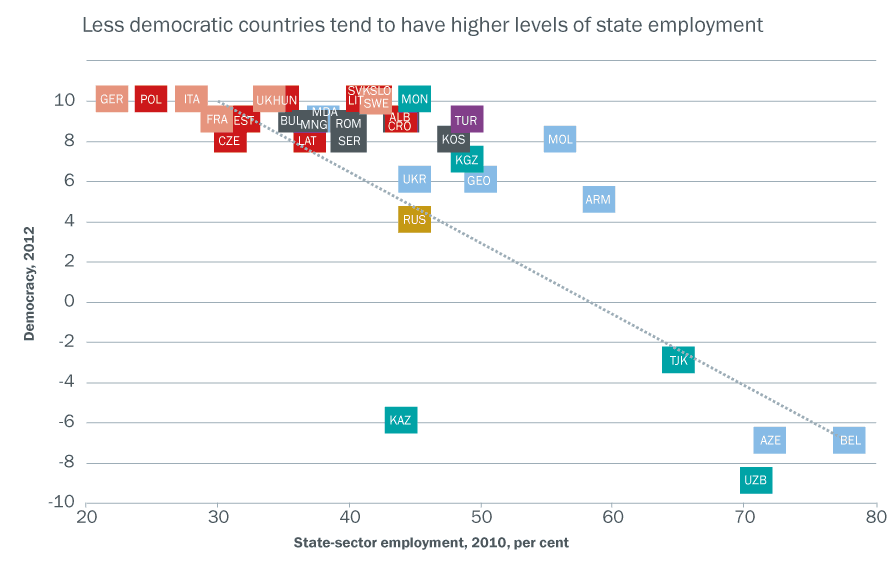Markets and democracy
Individual support for democracy
- Details
- Markets and democracy
The analysis so far suggests that early market reform and economic development promote democratisation and prevent democratic reversals, while natural resource endowments can be a hindrance. The causal channels through which these factors operate are demand for, or opposition to, democracy by specific groups benefiting from its presence or absence, and the impact of economic development on education (which is, in turn, assumed to influence democratic convictions).
Complementing the previous country-level analysis, this section uses household data from the 2010 round of the EBRD/World Bank Life in Transition Survey (LiTS) (see Chapter 5 of this Transition Report) to explore individual attitudes to democracy in the transition region.
The survey collected detailed socio-economic information on respondents and their households, and also asked respondents about their values and beliefs, including support for democracy.1
Using these data, one can test three hypotheses.
- Although the survey is not designed to cover the views of elites who might have an interest in opposing democratisation, it does include some groups who arguably derive economic benefits from maintaining the status quo in less democratic systems. These include public sector employees, specifically those in state-owned enterprises (SOEs), who may stand to lose from democratisation and market reforms.2Is there any evidence that these groups are less supportive of democracy than others in the same country?
- Are well-educated individuals more supportive of democracy than those with lower levels of educational attainment?
- Are individuals who have fared well under democratic systems more supportive of democracy? On the one hand, individuals who have seen their incomes rise may want to maintain a status quo that has benefited them; on the other, rising incomes may lead to greater demand for political participation, even for given levels of formal education.
We have used regression analysis to investigate whether household-level support for democracy is influenced by:
- respondents’ employment type (whether public servants, employees of SOEs or employees of private domestic or foreign-owned firms);
- the level of educational attainment (primary, secondary or tertiary);
- perceived progression up the income ladder over the previous four years;
- the age of the respondent.
The analysis is undertaken separately for consolidated democracies and less democratic regimes. The main results are as follows (see also Annex 2.1).
- As expected, employees of SOE are less likely to support democracy than those who work for private companies, whether in democracies or in less democratic countries. However, the effect is statistically significant only in the latter, where the probability of supporting democracy is about twice as low for SOEs’ employees as it is for private-sector employees.
- In democratic countries educated respondents with upper secondary and tertiary educations are more likely to support democracy than less educated respondents. Interestingly (and against all expectations), the opposite effect appears to hold in countries with very few constraints on the executive, although these effects are generally not statistically significant. The main exception is that highly educated public servants and employees of SOEs in less democratic regimes are far more likely to support democracy than peers with lower levels of educational attainment.
- Respondents from democratic market-oriented countries are more likely to support democracy if they think they are better off (compared with others) than they were four years previously, even if their relative position on the income ladder has not changed in those four years.3 This is not the case for less democratic countries.
These results are relevant to the prospects of further democratisation in the transition region. Countries with less democratic regimes – in which employees of SOEs tend to oppose democratisation – also have particularly high levels of state employment (see Chart 2.6). In Azerbaijan, Belarus and Uzbekistan state employment exceeds 70 per cent of total employment, while in Tajikistan it is over 60 per cent. This could slow the democratic transition process in these countries. More encouragingly, education seems to partly offset this effect, in that the more educated the state employee, the less likely he or she will be to oppose democratisation.
- Specifically, respondents were asked if they thought that democracy was preferable to any other political system, whether in some circumstances authoritarian government might be preferable, or whether it did not matter what system was in place. See EBRD (2011a) and EBRD (2011b). [back]
- This link is explored further in Chapter 3. [back]
- The 2010 LiTS asked respondents to evaluate their own position on a ladder ranging from 1 to 10 – where 1 corresponds to the poorest 10 per cent and 10 corresponds to the richest 10 per cent – at the current time, four years previously and four years hence. By taking the difference between these rankings, respondents' relative well-being in 2010 compared to 2006 can be measured, as can respondents' expected future well-being. [back]














